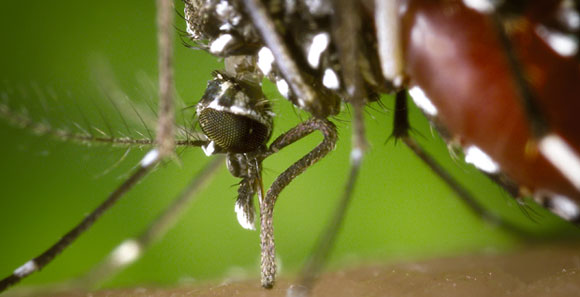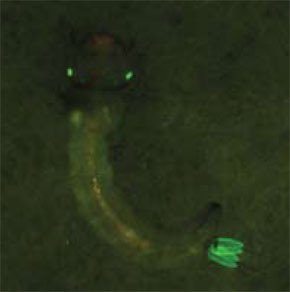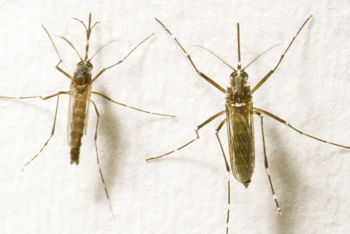
JAMES GATHANY / CDCThe elimination of female mosquitoes in the larva stage is a strategy that is currently being testedJAMES GATHANY / CDC
For animals, mating is a way to perpetuate the species. In the case of the Aedes aegypti, the mosquito that transmits dengue fever, this basic process is being inverted. By means of genetic manipulation, a population of lab-raised male mosquitoes was given a modified gene that produces a protein killing the offspring that result from mating with normal female mosquitoes found in any environment. This strategy might lead to the suppression of a significant number of these insects, reduce the pulverization of the insecticide necessary to eliminate them, and thus reduce the incidence of dengue fever in human beings.
The first genetically modified mosquitoes were set free in December 2010, after approval in this respect had been granted by the National Biosafety Technical Committee (CTNBio). The transgenic strain of the Aedes aegypti mosquito, which was developed by British company Oxford Insect Tecnologies (Oxitec), is scheduled to be set free as of this month in the municipal region of Juazeiro, State of Bahia. This work will be done by biologist Margareth Capurro, of the Biomedical Sciences Institute (ICB) at the University of São Paulo (USP), in partnership with Moscamed Brasil, a company headquartered in the town of Juazeiro.
Dengue fever is one of the leading public health problems in the world, especially in tropical countries like Brazil. According to the World Health Organization (WHO), 50 million people become infected every year, resulting in 550 thousand hospital stays and 20 thousand deaths. Nowadays, the only way to control this disease is to eliminate the insect that transmits it – namely, the Aedes aegypti mosquito. The transgenic insects developed by Oxitec could become an option for this task. The males of the OX513A strain – the name given by the company – are set free to mate with the wild females. The offspring inherit the lethal protein and die when they are still in the larva, or pupa, stage. They were programmed to survive when they get tetracycline, an antibiotic, so that they can be produced in the lab. Without this antidote, which represses the synthesis of the lethal protein, no survivors would be left to be set free in nature. The transgenic strain contains a fluorescent genetic marker that becomes visible when the mosquitoes are exposed to ultraviolet light. This ensures better quality control of the production of these mosquitoes and their dispersion in the field. The continuous release, in large quantities, of these genetically modified insects into infested environments is expected, in time, to reduce the wild population of these insects to a level below the level necessary to transmit the disease.

DANILO CARVALHO-ICB / USPLarvae of transgenic Aedes with fluorescent genetic markerDANILO CARVALHO-ICB / USP
The story of Margareth”s work with these mosquitoes began at a casual meeting during a conference in 2007. At the conference, Margareth met British scientist Luke Alphey, from the University of Oxford, and the founder of Oxitec. He proposed that she test, in Brazil, the transgenic mosquitoes that he had developed. At the time, the Brazilian researcher did not believe the experience would be feasible, because of legal and bureaucratic obstacles. A short while later she changed her mind and decided to conduct the experiment. To this end, she requested permission from CTNBio, the entity responsible for the regulation of transgenic products in Brazil, to import the insects. “The permission to import the insects was granted on September 21, 2009,” Margareth recalls. “One week later, we received an envelope with 5,000 eggs from Oxitec, at no cost.” The researcher started to raise the transgenic Aedes aegypti in her insect lab at the ICB. However, it was necessary to raise the insects on a large scale if they were to be set free and tested in the wild. In addition, it was also necessary to find the adequate site to do so; the site had to be isolated and have a population of wild mosquitoes. That was when Aldo Malavasi, a former professor of USP and founder of Moscamed, proposed to produce the transgenic mosquitoes at his biofactory and suggested that the mosquitoes be set free in isolated towns of the region of Juazeiro. Margareth accepted the proposal, and, to put it into practice, the company and USP entered into an agreement. Moscamed is not charging for this work. “These tests will provide us with exposure, technical training and, at the same time, we will have an alternative to control these insects,” Malavasi justified. The company produces sterile males that had been subject to the cobalt radiation used on the medfly (Ceratitis capitata) and on the New World screwworm fly (Cochliomyia hominivorax). These flies are set free in the region of Juazeiro and Petrolina, in the Vale do São Francisco river valley, State of Pernambuco, to compete with the wild males for the females. (see Pesquisa FAPESP nº 133).
Masses of insects
The mating does not produce any offspring. In time, the populations of these insects will dwindle. “As we have been raising a mass of insects for some time already, we are going to conduct the experiment, with the help of the infra structure provided by Moscamed, to multiply the transgenic mosquitoes,” Malavasi explains. “To this end, we have built a laboratory to work with the transgenic insects. Our lab has already been approved by the CTNBio.”
Moscamed”s team has chosen the appropriate places to conduct the field tests, which will take place in the semi-dry climate of the region that surrounds Juazeiro. “The tests will be conducted in five isolated sites that are separated from the town of Juazeiro by plantations, highways or unpopulated areas, and where there is a high incidence of the Aedes aegypti,” says Margareth. “In the water storage tank of a single house we found 300 larvae of the mosquito.” The researcher emphasizes another advantage of working in the chosen places. “Because of Moscamed”s work in the region, the local population is already accustomed to insects being set free in the environment,” she explains. “This is why the local inhabitants are not afraid of the mosquitoes that we are going to release.” Margareth emphasizes that only the male mosquitoes – that do not bite and do not transmit the disease – pokie online will be set free. Now that the CTNBio has granted the permission, the next step will be to conduct a dispersion study,, to assess the size of the local Aedes aegypti population. It is necessary to do so in order to calculate how many transgenic mosquitoes will have to be set free. Margareth explains that 5 to 10 transgenic mosquitoes will be released for each wild male. The researcher does not expect a significant reduction of the wild populations after the first lab-produced transgenic mosquitoes are released. “We will have to set the transgenic mosquitoes free for at least two summer seasons to significantly reduce the existing population,” she says.

EDUARDO CESARAedes : male, on the left, is harmless; female transmits dengue feverEDUARDO CESAR
Based on the results obtained in other places around the world where the Oxitec”s transgenic mosquitoes have been released, there are good reasons to expect that the experiment will also be successful in Brazil. Tests conducted last year in the Caribbean”s Cayman Islands, which involved the release of 3 million genetically modified mosquitoes, showed that 80% of the local population of wild mosquitoes had been eliminated. Similar results were obtained in Malaysia. These successful results have motivated other countries to use the British company”s transgenic mosquitoes to conduct the experiment as well. Oxitec has informed on its web site that France, India, Singapore, Thailand, the United States, and Vietnam have already approved the importing of these insects.
The path chosen by Oxitec to develop genetically modified mosquitoes is just one of the various paths that are being taken around the world. An example of this work was announced in early 2010, in an article published in the Proceedings of the National Academy of Sciences (PNAS) scientific journal. The article had been written by a team of international scientists, which includes Brazilian biologist Osvaldo Marinotti, a former researcher of USP and currently professor of the University of California in Irvine (UCI), in the United States. Instead of raising males of the Aedes aegypti species, that leave a mortal genetic inheritance for their descendants, they developed a transgenic female that is unable to fly. To this end, they took advantage of the natural difference between genders.
The males remain
The muscles that support the mosquitoes” flying ability are stronger in the females. Nobody knows exactly why this is so, but it is believed that this occurs because the female mosquitoes draw blood from other animals, including human beings, and carry the eggs. The females carry more weight and therefore need to have stronger wings. On a genetic level, the explanation for this difference is that the muscles that drive the flight of the female depend on a protein, called actin-4, which is coded (produced) by a gene that is much more active in the females than in the males. The males have the same gene, but this gene is expressed more mildly in the males. The males carry another kind of actin, which acts on the flight muscles. Scientists, aware of this difference, created a gene that produces a toxic substance for actin-4, preventing this protein – which is found in the flight muscles – from performing its function. This results in females that develop normally until the larva phase, but, when becoming adults, they are unable to fly. This is why they cannot come out of the water and they die, without reproducing and feeding on blood. Consequently, they do not leave any descendants and do not transmit the dengue fever; The transgenic males are able to fly, but this is not a problem. The male mosquitoes feed on nectar and plant juices. They also remain sexually active and mate with the wild females, thus transmitting the gene that prevents the female mosquitoes from flying.
Other strains of transgenic mosquitoes are the focus of research studies conducted by professor Margareth. One strain involves the mosquito that transmits malaria and the other strain involves the mosquito that transmits dengue fever. In the first case, Margareth removes a tick gene, responsible for the production of an antimicrobial peptide – a protein fragment – called microplusin. “This gene is modified so that it can be inserted into a mosquito,” the researcher explains. “Once the gene is inside the insect?s genome, it produces the microplusin, which eliminates the Plasmodium protozoa, a single-sell microorganism that is the agent of malaria, before it is transmitted to a human being.”
In the case of the dengue fever mosquito, a project funded by FAPESP, Margareth manipulates the insect”s genome in such a way that, when the genetically modified female is infected by the dengue fever virus after having fed on blood, proteins are produced that speed up apoptosis (the death of the cell), which in turn kills the insect. “The existence of the dengue fever virus activates the protein that induces the apoptosis, thus causing the cell death of all the tissues in the infected mosquitoes, and leads to the female”s death. As a result, the viral transmission is 100% blocked,” Margareth explains. Several gene introduction techniques are currently being tested to insert these transgenic mosquitoes into the wild. One of these techniques is referred to as Medea, because it induces – by means of biotechnological systems – the death of the non-transgenic offspring resulting from the mating of the normal females with the genetically manipulated males. “Only the offspring that carry the transgenic gene survive. The introduction of the transgenic gene into a population of mosquitoes through the Medeia technique takes only eight generations.” An additional benefit will be available if time and research studies prove that these strategies of using genetic engineering to create transgenic mosquitoes are efficient. This form of control will reduce the need to use insecticides and larvicides. Insecticides and larvicides might be less expensive in the short term, but insects create resistance to them. This is why the use of transgenic and sterile mosquitoes seems to be a good option for the future.
The project
Promoting mortality in Aedes aegypti infected by the dengue fever virus (nº 08/10254-1); Type Regular Research Awards; Coordinator Margareth Capurro – USP; Investment R$ 347,263.34 (FAPESP)